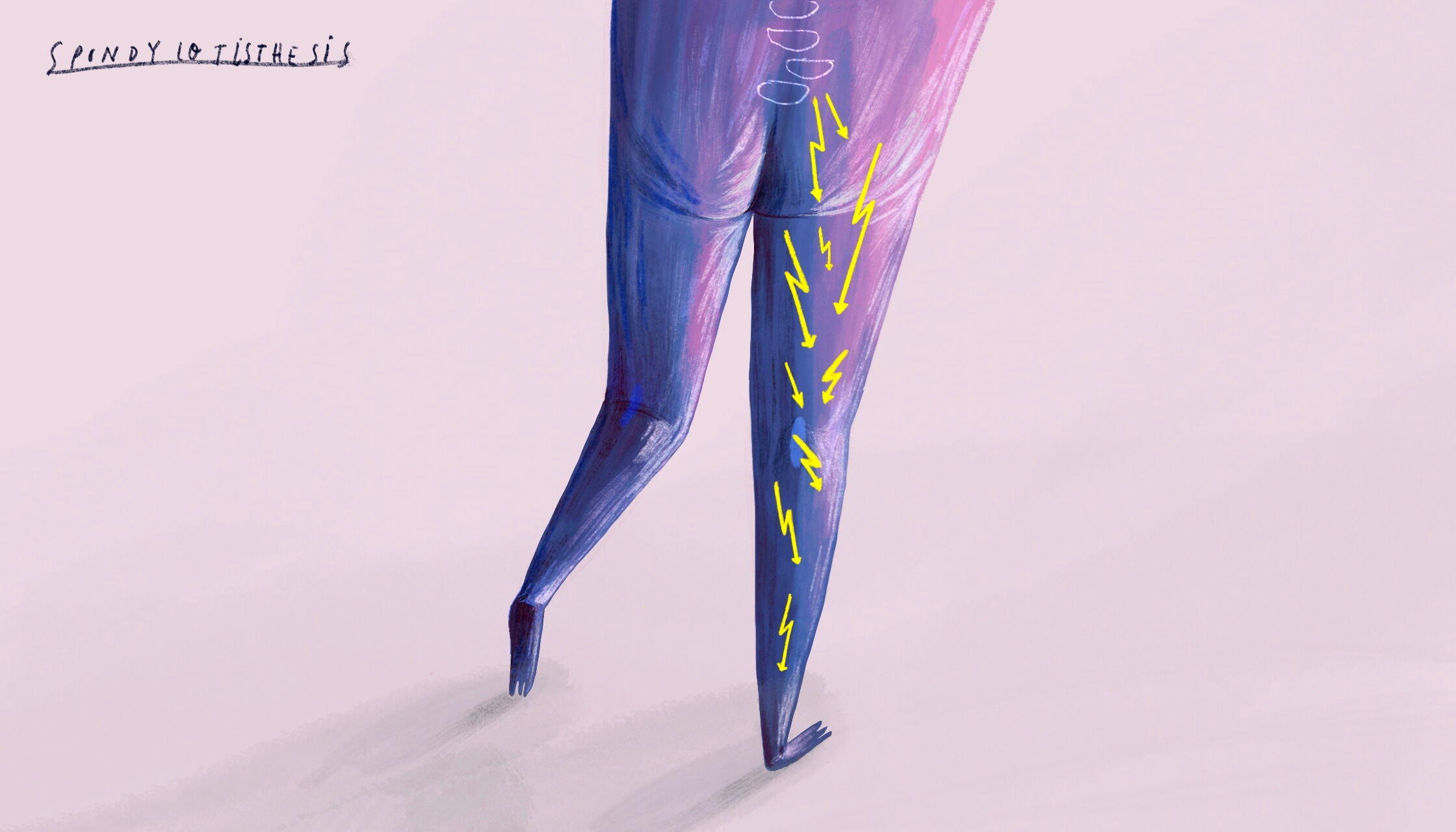Spondylolisthesis.
A spinal condition that causes back or nerve pain.

Neurosurgeon Brisbane
Spondylolisthesis key points
- This is a spinal condition in which one of the vertebrae slips either forward or backwards on another spinal bone.
- This causes back pain or nerve pain.
- There are two main treatment options: physiotherapy to strengthen the muscles, or surgery where we screw the two bones together so they don’t slip and slide on each other anymore.
Spondylolisthesis Brisbane
What is it?
‘Spondy’ means spine; ‘listhesis’ means slipping.
This is a condition in which one spinal bone slips either forward or backwards on another spinal bone.
It is one of the more common ways that wear and tear changes affect the spine. It most commonly occurs in the neck or back. It rarely occurs in the thoracic spine.
Spondylolisthesis symptoms
What are the symptoms?
We will concentrate on the lumbar spine as this is by far the most common part of the spine to be affected.
The two most common symptoms for spondylolisthesis are back pain and nerve pain.
The back pain is purely mechanical. As you move around in normal life, the two slipped bones essentially slide round on eachother. This is not a big movement, usually only measured in millimetres, but that is enough to cause mechanical pain.
The nerve pain is due to the slipped bones jamming the nerves coming out of the spine at that level.

Spinal surgeon Brisbane
Spondylolisthesis causes
What causes it? Did I do something to cause it?
The most common cause is wear and tear changes in the spine, specifically in the spinal disc.
The spinal disc is 80% water and over 1cm in height once you reach teenage years. With age, the disc loses water and so it collapses down in height, sometimes to less than 1mm. This often weakens the spinal disc and allows the two spinal bones it normally holds together to slip on each other.
Overall there are 5 causes of spondylolisthesis.
- Arthritis: It is very common for wear and tear to result in two bones slipping on each other.
- Congenital: This means you were born with it.
- Trauma: In rare cases, an accident can cause two bones to slip on each other.
- Cancer: Fortunately this is very rare.
- Surgery: Yes, sometimes spine surgery for a completely different issue can weaken the grip between two adjacent bones and so they start to slip and slide on each other. Fortunately, with the advent of keyhole surgery, this is becoming much less common. However, with more traditional spinal fusion the risk of this occurring is about 5-30% depending on the type of fusion.
A thorough assessment of you and your scans can usually work out which cause you have.
Most of the time no. It is just the pain it causes, either back or nerve pain, and the effect of that on your quality of life.
There is one genetic version, called isthmic spondylolisthesis. However, it is not a gene you inherit from your parents or pass onto your kids.
All the other causes are not genetic.
Spondylolisthesis treatment in Brisbane
How is it treated?
The first trick is to work out if the spondylolisthesis is actually giving you any symptoms. Most commonly it is silent and you can continue to live a normal life without restrictions.
If it is causing either back pain or nerve pain, and this has been confirmed after a very thorough clinical and radiological examination, then there are two main options.
Both these options are about the same thing, strengthening the part of the spine that has slipped. This can either be done by physiotherapy to strengthen the muscles or by surgery to screw the two bones together so they don’t slip and slide on each other anymore.
To determine the severity of spondylolisthesis, we give it a grade. It is really just a fancy numbering system to describe how far one bone has slipped on the other.
- Grade 1 means one bone has slipped less than 25% (this is not very far for the bone to slip, usually measured in a few millimeters, and is the most common grade).
- Grade 2 means one bone has slipped between 25 and 50%
- Grade 3 means one bone has slipped between 50 and 75% (this is a long way for the bone to slip and is actually quite rare).
- Grade 4 means the bones have slipped more than 75% on eachother.
- Spondlylopsis means the bones have completely fallen off each other! This is very rare indeed.
Spondylolisthesis surgery in Brisbane
Do I need surgery?
Surgery can stop the two bones from slipping and sliding on each other which in turn helps treat spinal pain. The pain comes from the bad movement between two bones, or bone rubbing on bone, so by eliminating the movement by screwing the two bones together the movement is instantly stopped forever and the pain is treated as a result.
Surgery can also treat nerve pain caused by spondylolisthesis. Once again, by screwing the bones together this repeated jamming of the nerve tends to stop and so the nerve pain improves. Furthermore, the nerve can also be squashed by a build-up or arthritis tissue. Surgery can very easily remove this thickened tissue and take the pressure off the nerves which is very effective at removing the nerve pain.
Whether or not you need surgery comes down to one factor: your quality of life. It is rarely a dangerous medical condition so it just comes down to how badly the symptoms are holding you back in life.

Spinal surgeon Brisbane
If you would like me to make this assessment with you, please feel free to contact my team to make an appointment.
This is one condition of the spine that actually responds very well to surgery. The reason for this is simple. Spondylolisthesis is purely a mechanical problem; it is one bone slipping and sliding unnaturally on another bone. And surgery is very good at fixing purely mechanical problems. By screwing the two bones together this slipping and sliding problem is fixed and more often than not you will feel a lot better and be able to get back to normal life once the recovery is done.
Good question. To get the best result you need to commit to a full recovery period.
“Recovery is like compound interest; if you do the time, you’ll get the best result. If you shortchange yourself and bail out early you will miss out on significant benefits long term.”
But this does not mean you will be resting during the recovery. I will actually encourage you to be as active as possible. There is a very important reason for this. It is critical to get your confidence back as soon as possible.
There are generally two main restrictions. One is not to lift more than 20kg for 6 months and the other is to avoid excessive twisting for 6 months.
I will talk to you about what is required. You’ll be surprised actually how much you are allowed to do. I will take you through all the details if you have surgery with me. In the meantime, there is more detailed information here on postoperative recovery and what it looks like and what the important things are to get the very best outcome.
Physiotherapy, injections and medication carry no real inherent risk, other than the effect may not last.
Risks of surgery depend on what exactly needs to be done and, as your spine surgeon, I will take you through this in detail when I see you.
You absolutely can. As mentioned above, it is generally not a dangerous medical condition, and it is unlikely you will do further damage. It all comes down to your quality of life and whether you are coping or not.
There are many things to consider when working out what’s the best plan for you, including your symptoms, your scans, examination findings, level of activity and aspirations and hobbies in life. If you would like me to take you through this process for the best outcome, then contact my team.
Spondylolisthesis specialist in Brisbane
What should I do now?
If you would like me to assess your symptoms then contact my team. We will arrange all the necessary scans for you in the meantime so that we can have a complete discussion when we meet.
Ready to make an appointment?
Ramsay Specialist Centre
Suite 325
Newdegate St
Greenslopes QLD 4120

